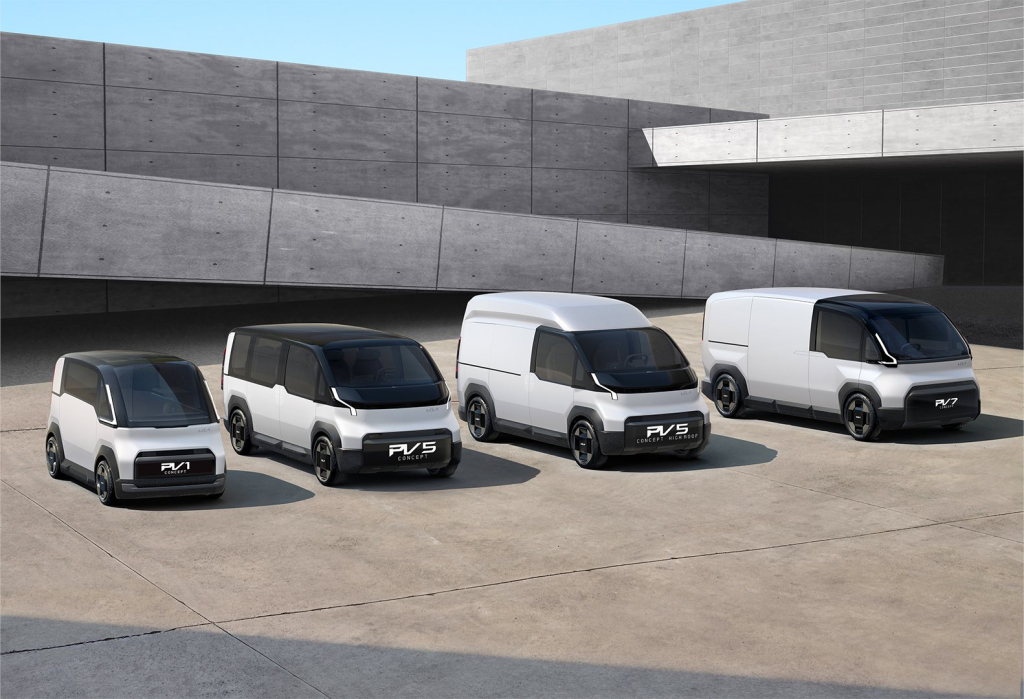Kia plans to unveil three new all-electric vehicles at the 2024 Consumer Electronics Show (CES) to revolutionize personal and B2B mobility. Production for the range will begin in 2025.
Kia to Exhibit 3 New All-Electric Vehicles at CES 2024
The three cars, termed "PV1," "PV5," and "PV7," will vary in size and target audience and will include a revolutionary new platform known as the Platform Beyond Vehicle (PBV)—more on that later, as per Top Gear.
The PV1, the first of the three vehicles, is the most nimble and compact in the lineup, and it will focus on short-distance logistics, such as fast trips to drop off those soon-to-expire flowers to your loved one. It looks to be close in size to compact city automobiles like the Toyota IQ, so your Saint Bernard should fit right in.
The second vehicle, the PV5, will be shown at CES in three different trim levels (Basic, High Roof, and Van), and it is anticipated to be the most popular car in the PBV portfolio because it seems to have mid-sized van dimensions, akin to a Ford Transit Connect.
Finally, the PV7 will be the largest of the three, offering the most cargo room and driving range. Initial photos reveal it to be somewhat longer than the PV5 but not significantly taller.
Exploring Kia's Futuristic PBV Technology: Redefining Mobility With AI and Robotics
Now that we've covered the basic design of the new cars let's look at how they'll operate and why they may be revolutionary. To accomplish this, we must first familiarize ourselves with the new platform.
The PBV will aim to provide greater versatility and adaptability to a variety of personal and professional lifestyles thanks to a forward-thinking, customer-centric design that incorporates Kia's most recent autonomous driving, advanced air mobility, and robotics technology. The platform will also include a redesigned internal arrangement that maximizes space through effective packing.
Kia will subsequently introduce the PV1 and PV7 models as part of its second phase, with the goal of making these vehicles entirely AI-powered. According to Kia, this era might witness the birth of new companies based on robots and other futuristic technology, such as flying cars that bring soon-to-expire flowers directly to your home.
Finally, phase three will witness the development and eventual integration of a complete mobility "environment," in which Kia's PBV cars will interconnect to become part of an operational smart city powered by local energy grids. Yes, this is real Marty McFly territory now; we wonder how big the person's brain is or, more likely, how much tequila they drank before coming up with this.
Other essential features of these PBVs include using "Easy Swap" technology, which allows a single vehicle's chassis to be reused throughout a whole 24-hour period. During the day, it may function as a taxicab, while a short battery switch in the evening transforms it into an overnight delivery truck. Or it may simply go wild, resulting in an army of autonomous cars to fight.
To bring these cars and the related PBV platform to reality, Kia will build a specialized "EVO plant" facility in "Autoland" Hwaseong, Korea, which will be operational by 2025. Details on a UK rollout will be announced in due time.
Kia plans to produce over 150,000 automobiles annually at the facility, perhaps requiring Will Smith to reprise his role as humanity's savior in iRobot. And against a swarm of mechanical sword- and shield-wielding vehicles, as opposed to 200 intelligent humanoid robots.
Photo: Kia Worldwide/X



 OpenAI Disbands Team Tackling AI Risks Amid Leadership Changes and GPT-4o Launch
OpenAI Disbands Team Tackling AI Risks Amid Leadership Changes and GPT-4o Launch  Microsoft Integrates AMD AI Chips into Azure, Competing with Nvidia’s GPU Offerings
Microsoft Integrates AMD AI Chips into Azure, Competing with Nvidia’s GPU Offerings  Altcoins a ‘Relatively Huge’ Risk as Big Returns Fade, Analysts Warn Investors
Altcoins a ‘Relatively Huge’ Risk as Big Returns Fade, Analysts Warn Investors  High FDVs on Binance Listings Lead to Investor Losses, Analysis Reveals
High FDVs on Binance Listings Lead to Investor Losses, Analysis Reveals  CPI Report Spurs Optimism, BlackRock CIO Forecasts Fixed Income Growth
CPI Report Spurs Optimism, BlackRock CIO Forecasts Fixed Income Growth  Binance Enhances SHIB, USTC, AGIX Trading and Liquidity for Better Market Dynamics
Binance Enhances SHIB, USTC, AGIX Trading and Liquidity for Better Market Dynamics  Tesla Offers Model 3 Demo Vehicles at Discounted Prices in U.S. and Canada
Tesla Offers Model 3 Demo Vehicles at Discounted Prices in U.S. and Canada  Massive SHIB Transfers Occur Despite Sharp Decline in Shibarium Transactions
Massive SHIB Transfers Occur Despite Sharp Decline in Shibarium Transactions  Tether's $1B USDT Mint Boosts Bitcoin, Eyes on $70K Milestone
Tether's $1B USDT Mint Boosts Bitcoin, Eyes on $70K Milestone  $73M Crypto Scam: Two Foreign Nationals Arrested for 'Pig Butchering'
$73M Crypto Scam: Two Foreign Nationals Arrested for 'Pig Butchering'  Ex-OpenAI Exec Criticizes Sam Altman's Focus on 'Shiny Products' Over AI Safety Concerns
Ex-OpenAI Exec Criticizes Sam Altman's Focus on 'Shiny Products' Over AI Safety Concerns  Over 50 Million USDT Blacklisted by Tether Amid Regulatory Scrutiny, Details Inside
Over 50 Million USDT Blacklisted by Tether Amid Regulatory Scrutiny, Details Inside  SHIB Whale Activity Surges Amid Plummeting Shibarium Transaction Volumes
SHIB Whale Activity Surges Amid Plummeting Shibarium Transaction Volumes  Bitcoin's Rise Fueled by $222M ETF Inflow: What’s Next for BTC?
Bitcoin's Rise Fueled by $222M ETF Inflow: What’s Next for BTC?  Shibarium Faces 97% Drop in Transactions, Yet Transfers Rise Steadily
Shibarium Faces 97% Drop in Transactions, Yet Transfers Rise Steadily  Crucial SHIB Warning Goes Out: Fake Airdrop Scams Targeting Community, Here's Reason
Crucial SHIB Warning Goes Out: Fake Airdrop Scams Targeting Community, Here's Reason  AI 'Godfather' Warns of Job Displacement, Advocates for Universal Basic Income
AI 'Godfather' Warns of Job Displacement, Advocates for Universal Basic Income 





























